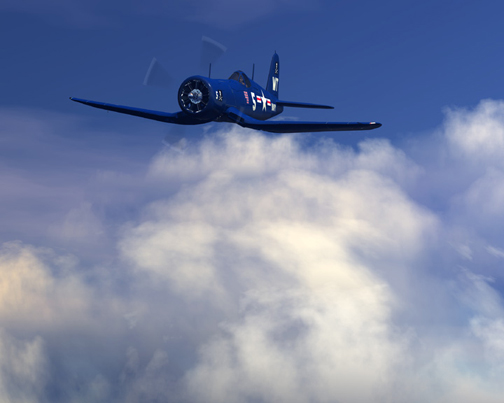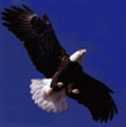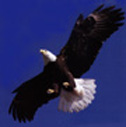|
Corsair Action Off Okinawa
Klingman's Fight With The Enemy
On May 10th, one of the most unique fighter interceptions of WWII took place. Captain Ken Reusser, callsign Ruby 6, was on patrol with 3 other Checkerboarders over the island of Okinawa. The following excerpt is from an article published in the May '95 edition of Leatherneck. The author is Ray Schanamann, 1st Lt, VMF-312
The pilots started their climb to altitude, prepared for another routine patrol. Instead, they received a transmission from "Handyman", the Air Defense Control Center. "Ruby 6, this is Handyman, over." "Handyman, Ruby 6, go ahead." "Ruby 6, Handyman, We have a bogey approaching on course one eight zero,angels 25 (altitude 25,000 feet). Climb to angels 25, steer 270, buster (full speed), over." "Handyman, Roger, course 270 angels 25, out."
The flight dropped their belly tanks, test fired their guns, put their props in full low pitch, and firewalled their throttles. Klingman remembered, "We could see the vapor trails as the bogey made two complete circles over the harbor." The Marines had a good idea about the plane they were pursuing. For several days that week their squadron and others took turns trying to intercept a plane that followed the same flight plan. Intelligence believed the plane was on photo reconnaissance of the ships in the harbor, for use in planning kamikaze raids. The previous intercept attempts failed because the intruder, aware of the chase planes, kept climbing as he headed for home. With his initial altitude advantage he easily outran his pursuers. This time the Marines tried to close while climbing at their best speed. Captain Reusser said, "We were turning inside him to try and join up, but we were so far below him we had little chance of reaching him. I just pulled the nose up and held the trigger down, no aim, no accuracy, just trying to loop it up there. I saw a couple of glints, but I remember I didn't think anything of it at the time. He leveled off and headed back toward Japan."
The division kept climbing and stayed on the bogey's tail even though it didn't seem possible to overhaul him. Captain Jim Cox's plane fell back until he was about a thousand feet below the others — he couldn't coax another knot of speed out of the battle-weary Corsair. Reusser ordered Cox and 1st Lt. Frank Watson to return to orbit over Point Nan while he and Klingman continued the pursuit.
Now they were at 38,000 feet, the service ceiling for the Corsair. The bogey was still about a mile ahead, and the chase continued. Because of the thin air and limited power, maneuvers had to be limited to small, careful changes in direction or altitude; otherwise a stall or spin would result with small chance of recovery. At such an altitude bailing out would have meant freezing to death. " As we got closer, Ken was firing, and I guess the bogey was firing at us. I had a few small bullet holes in the plane. My plane had no gun heaters and the guns were frozen, but I was pretty eager to get me a Jap plane. My plane was faster because it was a brand new so I went on ahead of Ken at max speed and streamlined as much as I could."

"We closed on the bogey until I was 20 or 30 feet behind him-I couldn't get any closer to him due to his prop wash. It held me back and kept me from running into him. I had to slowly climb above the airplane, and then I nosed over and ran into his tail with my prop. I only had enough extra speed to chew off some of his rudder and elevator before being blown away (from Nick's prop wash) Since he was still flying, I climbed above him for a second run. I nosed down and I pulled out too soon and only got some of his rudder and part of the top of the rear canopy. At this time I remember seeing the rear seat gunner frantically looking around and trying to operate his machine gun. I imagine at this altitude he was probably freezing to death. I realized that a third wasn't necessary, but I was even more determined so I climbed above him for my third run and chopped the right side of his elevator, and we both went into a spin. This run did the most damage to my plane, but I recovered after losing only about 1,000 feet. Ken was along side then, and we both observed the enemy plane in a spin with both wings coming off at about 15,000 feet."
Reusser had a bird's-eye view when Klingman first passes were made and related. "The Japanese gunner pounded on his machine gun to free it up, but it was frozen solid and so was mine. When Bob came down on the canopy with his prop, he tore the gun away from the mount and hit the gunner. His plane was full of bullet holes and shrapnel holes from fragments of the Nick." Klingman had his kill but they were hundreds of miles from base and his plane shook and vibrated with the stick jumping in a large circle. Close to home at about 10,000 feet Bob ran out of fuel but felt he could still reach the strip even though Ken suggested he bail. Pilots stood quietly at the upwind end of the runway. They watched the Corsair plunge silently in a steep glide — no engine roar, the prop windmilling slowly. "Don't stretch the glide: don't be short.: they said almost prayerfully. At the last possible second, Klingman raised the Corsair's nose and the plane slammed into the ground and bounced the few remaining feet onto the airstrip. Watchers gasped as they saw the planes condition. The tips of all three blades jutted outward with 6 inches missing from each end and the blades pierced by bullets; each wing contained large holes, and pieces of the Nick were in the cowling.
After extensive tests and a new propeller, the F4U Corsair Bob Klingman used in the downing of the Japanese Nick was returned to service! Bob Klingman and Ken Reusser both received the Navy Cross for their actions.
***********************************************
Bob Klingman went on to retire from the Marine Corps. He died recently and there wasn't much fanfare except from some of the old Corsair pilots still alive around Orange county.
|



